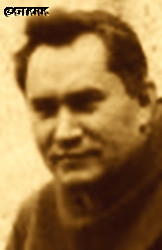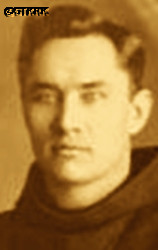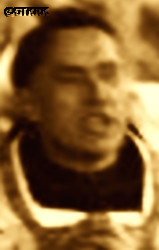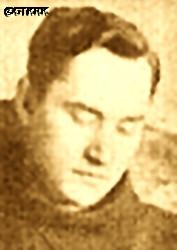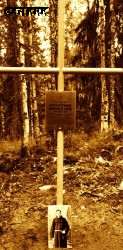Roman Catholic
St Sigismund parish
05-507 Słomczyn
85 Wiślana Str.
Konstancin deanery
Warsaw archdiocese, Poland
full list:
displayClick to display full list

searchClick to search full list by categories
wyświetlKliknij by wyświetlić pełną listę po polsku

szukajKliknij by przeszukać listę wg kategorii po polsku

Martyrology of the clergy — Poland
XX century (1914 – 1989)
personal data
surname
DIRVELĖ
forename(s)
Anthony (pl. Antoni)
forename(s)
versions/aliases
Antanas
religious forename(s)
Augustine (pl. Augustyn)
religious forename(s)
versions/aliases
Augustinas
function
religious cleric
creed
Latin (Roman Catholic) Church RCmore on
en.wikipedia.org
[access: 2014.09.21]
congregation
Order of Friars Minor OFMmore on
en.wikipedia.org
[access: 2013.05.19]
(i.e. Franciscans, Minorites)
diocese / province
Lithuanian province OFM
nationality
Lithuanian
date and place
of death
1948

ITL SevPechLagGuLAG slave labour camp network
today: n. Pechora, Komi rep., Russia
alt. dates and places
of death
Vorkutatoday: Komi rep., Russia
more on
en.wikipedia.org
[access: 2024.01.26]
details of death
After German and Russian invasion of Poland in 09.1939 and start of the II World, after start of Lithuanian occupation of part of Polish Vilnius county in 09.1939 and after Russian annexation of Lithuania in 06.1940, arrested by the Russians on 12.07.1940 while attempting to cross a newly established German–Russian border to Germany, where his co‐brothers from Kretinga monastery already moved.
Held in Franciscan St Anthony college building where murderous NKVD set up its HQ.
Next taken to Kaunas prison.
Repeatedly interrogated and tortured.
On 01.04.1941 transported in cattle train truck to Moscow.
Held in Presnya district prison for a few days and next transported out north.
Prob. sent to ITL SevPechLag slave labour concentration camp n. Pechora, on Kotlas–Vorkuta railway line.
There — prob. at a camp in Kosyu village on the river Kosyu, c. 70 km from Pechora — slaved at forest clearances and railway construction.
Fate thereafter unknown — according to some sources in c. 1947 attempted to flee towards Finland.
Possibly captured and then shot dead by Russian guards or bitten to death by camps' dogs — 1948 is usually mentioned as year of death.
cause of death
extermination
perpetrators
Russians
sites and events
ITL SevPechLagClick to display the description, GulagClick to display the description, Moscow (Butyrki)Click to display the description, Ribbentrop‐MolotovClick to display the description, Pius XI's encyclicalsClick to display the description
date and place
of birth
03.04.1901

Juodupėnaitoday: Slavikai eld., Šakiai dist., Marijampolė Cou., Lithuania
more on
lt.wikipedia.org
[access: 2020.07.31]
religious vows
14.09.1925 (permanent)
presbyter (holy orders)
ordination
15.07.1928

positions held
1940
friar — Kretingatoday: Kretinga dist., Klaipėda Cou., Lithuania
more on
en.wikipedia.org
[access: 2023.04.02] ⋄ monastery, Franciscans OFM
1939 – 1940
friar — Pajūristoday: Pajūris eld., Šilalė dist., Tauragė Cou., Lithuania
more on
en.wikipedia.org
[access: 2023.04.02] ⋄ monastery, Franciscans OFM — also: prob. vicar of local parish
1936 – 1939
Provincial — Lithuanian province, Franciscans OFM — also: founder of the Congregation of the Sisters of Our Lady of Perpetual Help (1936)
1936 – 1939
resident — Kretingatoday: Kretinga dist., Klaipėda Cou., Lithuania
more on
en.wikipedia.org
[access: 2023.04.02] ⋄ monastery, Franciscans OFM — also: rector of St Anthony college, i.e. gymnasium for boys; publisher of „Misijų metroštį”, i.e. Eng. „Missionary Yearbook” (till 1940); editor of the „Pranciškonų pasaulis”,, i.e. Eng. „Franciscan World” magazine (till 1940)
1931 – 1936
guardian — Kretingatoday: Kretinga dist., Klaipėda Cou., Lithuania
more on
en.wikipedia.org
[access: 2023.04.02] ⋄ monastery, Franciscans OFM — also: founder (1931) and rector (from 1932) of St Anthony college, i.e. gymnasium for boys; publisher of the weeklies „Sursum Corda” (1930‐1934), „Misijų metroštį”, i.e. Eng. „Missionary Yearbook” (from 1934); editor of the „Švento Pranciškaus varpelis”, i.e. Eng. „St Francis Bell” magazine (1934‐1936)
1930 – 1931
missionary — (United States of America territory)today: United States of America
more on
en.wikipedia.org
[access: 2022.08.05] — preached sermons and retreats in parishes of the Lithuanian diaspora, collecting funds for the construction of a Franciscan higher school in Lithuania
1929 – 1930
friar — Kretingatoday: Kretinga dist., Klaipėda Cou., Lithuania
more on
en.wikipedia.org
[access: 2023.04.02] ⋄ monastery, Franciscans OFM — also: editor of the „Švento Pranciškaus varpelis” (Eng. „St Francis Bell”) magazine
1928 – 1929
friar — KaunasŽaliakalnis district
today: Kaunas city dist., Kaunas Cou., Lithuania
more on
en.wikipedia.org
[access: 2022.06.30] ⋄ monastery, Franciscans OFM
1924 – 1928
student — Wrocławform.: Karłowice village
today: part of Karłowice‐Różanka neighborhood, Wrocław city pov., Lower Silesia voiv., Poland
more on
en.wikipedia.org
[access: 2021.04.02] ⋄ Higher Theological Seminary „Antonianum”, St Anthony of Padua monastery (at 26 John Kasprowicz Ave.), Franciscans OFM
1923 – 1924
student — Kaunastoday: Kaunas city dist., Kaunas Cou., Lithuania
more on
en.wikipedia.org
[access: 2022.06.29] ⋄ philosophy and theology, Theological Seminary — resident of the monastery in Žaliakalnis district
1921 – 1922
novitiate — Kretingatoday: Kretinga dist., Klaipėda Cou., Lithuania
more on
en.wikipedia.org
[access: 2023.04.02] ⋄ monastery, Franciscans OFM — prob.
10.09.1921
accession — Kretingatoday: Kretinga dist., Klaipėda Cou., Lithuania
more on
en.wikipedia.org
[access: 2023.04.02] ⋄ monastery, Franciscans OFM
sites and events
descriptions
ITL SevPechLag: Russian Rus. Исправи́тельно‐Трудово́й Ла́герь (Eng. Corrective Labor Camp) ITL Rus. Северо‐Печорский (Eng. North‐Pechora) — concentration and slave forced labor camp (within the Gulag complex) — headquartered in the town of Abez on the Usa River, and then the Pechora railway station on the North Pechora Railway Main Line in the Komi Republic. Founded on 14.05.1940. Prisoners slaved at forest clearing, construction, increase in capacity and maintenance of part of the Kotlas‐Voruta railway line on the 457 km long section from Ust‐Kozhva to Vorkuta , extension of the railway line from Vorkuta to Chalmer‐Yu (c. 70 km), branches from Khanowa to the nearby mine No. 7, at the construction of the first 40 km of the railway line from Chum towards the mouth of the Ob River, at construction of river ports and shipyards on the Pechora River, repair and mechanical workshops, power plants, factories, residential houses, food production, etc. At its peak c. 103,000 prisoners were held there: e.g. 91,664 (15.06.1941); 102,354 (01.01.1942); 58,825 (01.01.1943); 56,615 (01.01.1947); 47,815 (01.01.1948); 39,436 (01.01.1949); 42,028 (01.01.1950). Ceased to exist on 24.07.1950, and the prisoners were transferred to ITL PechorLag. (more on: old.memo.ruClick to attempt to display webpage
[access: 2024.04.08])
Gulag: The acronym Gulag comes from the Rus. Главное управление исправительно‐трудовых лагерей и колоний (Eng. Main Board of Correctional Labor Camps). The network of Russian concentration camps for slave labor was formally established by the decision of the highest Russian authorities on 27.06.1929. Control was taken over by the OGPU, the predecessor of the genocidal NKVD (from 1934) and the MGB (from 1946). Individual gulags (camps) were often established in remote, sparsely populated areas, where industrial or transport facilities important for the Russian state were built. They were modeled on the first „great construction of communism”, the White Sea‐Baltic Canal (1931‐1932), and Naftali Frenkel, of Jewish origin, is considered the creator of the system of using forced slave labor within the Gulag. He went down in history as the author of the principle „We have to squeeze everything out of the prisoner in the first three months — then nothing is there for us”. He was to be the creator, according to Alexander Solzhenitsyn, of the so‐called „Boiler system”, i.e. the dependence of food rations on working out a certain percentage of the norm. The term ZEK — prisoner — i.e. Rus. заключенный‐каналоармец (Eng. canal soldier) — was coined in the ITL BelBaltLag managed by him, and was adopted to mean a prisoner in Russian slave labor camps. Up to 12 mln prisoners were held in Gulag camps at one time, i.e. c. 5% of Russia's population. In his book „The Gulag Archipelago”, Solzhenitsyn estimated that c. 60 mln people were killed in the Gulag until 1956. Formally dissolved on 20.01.1960. (more on: en.wikipedia.orgClick to attempt to display webpage
[access: 2024.04.08])
Moscow (Butyrki): Harsh transit and interrogation prison in Moscow — for political prisoners — where Russians held and murdered thousands of Poles. Founded prob. in XVII century. In XIX century many Polish insurgents (Polish uprisings of 1831 and 1863) were held there. During Communist regime a place of internment for political prisoners prior to a transfer to Russian slave labour complex Gulag. During the Great Purge c. 20,000 inmates were held there at any time (c. 170 in every cell). Thousands were murdered. (more on: en.wikipedia.orgClick to attempt to display webpage
[access: 2020.05.01])
Ribbentrop‐Molotov: Genocidal Russian‐German alliance pact between Russian leader Joseph Stalin and German leader Adolf Hitler signed on 23.08.1939 in Moscow by respective foreign ministers, Mr. Vyacheslav Molotov for Russia and Joachim von Ribbentrop for Germany. The pact sanctioned and was the direct cause of joint Russian and German invasion of Poland and the outbreak of the World War II in 09.1939. In a political sense, the pact was an attempt to restore the status quo ante before 1914, with one exception, namely the „commercial” exchange of the so‐called „Kingdom of Poland”, which in 1914 was part of the Russian Empire, fore Eastern Galicia (today's western Ukraine), in 1914 belonging to the Austro‐Hungarian Empire. Galicia, including Lviv, was to be taken over by the Russians, the „Kingdom of Poland” — under the name of the General Governorate — Germany. The resultant „war was one of the greatest calamities and dramas of humanity in history, for two atheistic and anti‐Christian ideologies — national and international socialism — rejected God and His fifth Decalogue commandment: Thou shall not kill!” (Abp Stanislav Gądecki, 01.09.2019). The decisions taken — backed up by the betrayal of the formal allies of Poland, France and Germany, which on 12.09.1939, at a joint conference in Abbeville, decided not to provide aid to attacked Poland and not to take military action against Germany (a clear breach of treaty obligations with Poland) — were on 28.09.1939 slightly altered and made more precise when a treaty on „German‐Russian boundaries and friendship” was agreed by the same murderous signatories. One of its findings was establishment of spheres of influence in Central and Eastern Europe and in consequence IV partition of Poland. In one of its secret annexes agreed, that: „the Signatories will not tolerate on its respective territories any Polish propaganda that affects the territory of the other Side. On their respective territories they will suppress all such propaganda and inform each other of the measures taken to accomplish it”. The agreements resulted in a series of meeting between two genocidal organization representing both sides — German Gestapo and Russian NKVD when coordination of efforts to exterminate Polish intelligentsia and Polish leading classes (in Germany called «Intelligenzaktion», in Russia took the form of Katyń massacres) where discussed. Resulted in deaths of hundreds of thousands of Polish intelligentsia, including thousands of priests presented here, and tens of millions of ordinary people,. The results of this Russian‐German pact lasted till 1989 and are still in evidence even today. (more on: en.wikipedia.orgClick to attempt to display webpage
[access: 2015.09.30])
Pius XI's encyclicals: Facing the creation of two totalitarian systems in Europe, which seemed to compete with each other, though there were more similarities than contradictions between them, Pope Pius XI issued in 03.1937 (within 5 days) two encyclicals. In the „Mit brennender Sorge” (Eng. „With Burning Concern”) published on 14.03.1938, condemned the national socialism prevailing in Germany. The Pope wrote: „Whoever, following the old Germanic‐pre‐Christian beliefs, puts various impersonal fate in the place of a personal God, denies the wisdom of God and Providence […], whoever exalts earthly values: race or nation, or state, or state system, representatives of state power or other fundamental values of human society, […] and makes them the highest standard of all values, including religious ones, and idolizes them, this one […] is far from true faith in God and from a worldview corresponding to such faith”. On 19.03.1937, published „Divini Redemptoris” (Eng. „Divine Redeemer”), in which criticized Russian communism, dialectical materialism and the class struggle theory. The Pope wrote: „Communism deprives man of freedom, and therefore the spiritual basis of all life norms. It deprives the human person of all his dignity and any moral support with which he could resist the onslaught of blind passions […] This is the new gospel that Bolshevik and godless communism preaches as a message of salvation and redemption of humanity”… Pius XI demanded that the established human law be subjected to the natural law of God , recommended the implementation of the ideal of a Christian state and society, and called on Catholics to resist. Two years later, National Socialist Germany and Communist Russia came together and started World War II. (more on: www.vatican.vaClick to attempt to display webpage
[access: 2023.05.28], www.vatican.vaClick to attempt to display webpage
[access: 2023.05.28])
sources
personal:
lt.wikipedia.orgClick to attempt to display webpage
[access: 2018.09.02], archyvas.istorijoszurnalas.ltClick to attempt to display webpage
[access: 2018.09.02], www.bernardinai.ltClick to attempt to display webpage
[access: 2018.09.02], old.kretingospranciskonai.ltClick to attempt to display webpage
[access: 2018.09.02]
original images:
www.bernardinai.ltClick to attempt to display webpage
[access: 2018.09.02], www.ve.ltClick to attempt to display webpage
[access: 2018.09.02], www.europeana.euClick to attempt to display webpage
[access: 2018.09.02], www.bernardinai.ltClick to attempt to display webpage
[access: 2018.09.02], old.kretingospranciskonai.ltClick to attempt to display webpage
[access: 2018.09.02], ofm.ltClick to attempt to display webpage
[access: 2018.09.02]
LETTER to CUSTODIAN/ADMINISTRATOR
If you have an Email client on your communicator/computer — such as Mozilla Thunderbird, Windows Mail or Microsoft Outlook, described at WikipediaPatrz:
en.wikipedia.org, among others — try the link below, please:
LETTER to CUSTODIAN/ADMINISTRATORClick and try to call your own Email client
If however you do not run such a client or the above link is not active please send an email to the Custodian/Administrator using your account — in your customary email/correspondence engine — at the following address:

giving the following as the subject:
MARTYROLOGY: DIRVELĖ Anthony
To return to the biography press below:
 Click to return to biography
Click to return to biography








